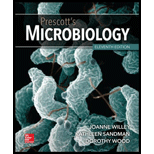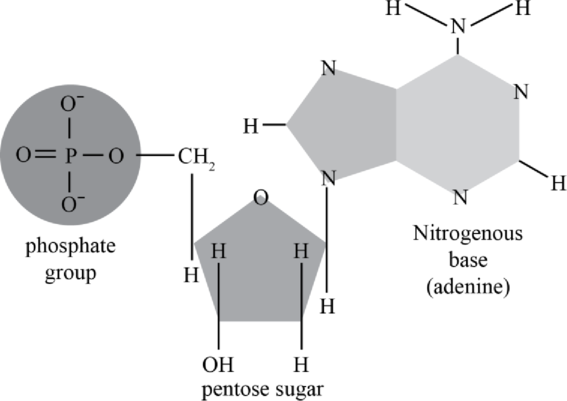
Prescott's Microbiology
11th Edition
ISBN: 9781260409062
Author: WILLEY, Joanne
Publisher: MCGRAW-HILL HIGHER EDUCATION
expand_more
expand_more
format_list_bulleted
Question
Chapter 16, Problem 1RC
Summary Introduction
To determine: A simple diagram that illustrates the three chemical moieties that define a
Introduction: A nucleotide can be defined as the molecule which contains a nitrogenous base, a five-carbon sugar, and a phosphate group. The nitrogenous base can be adenine, guanine, cytosine, or thymine. In RNA thymine is replaced by uracil and carbon sugar must be ribose type and deoxyribose is present in DNA.
Expert Solution & Answer
Explanation of Solution
A nucleotide can be defined as the combined form of nucleoside and a phosphate group. It forms both DNA and RNA. It helps in cell signaling, enzyme reactions, and in many other pathways.
Pictorial representation:

Fig.1: A diagram showing three chemical moieties of a nucleotide
Want to see more full solutions like this?
Subscribe now to access step-by-step solutions to millions of textbook problems written by subject matter experts!
Students have asked these similar questions
Analyze the effectiveness of the a drug treatment program based on the needs of 18-65 year olds who are in need of treatment by critically describing 4 things in the program is doing effectively and 4 things the program needs some improvement.
I have the first half finished... just need the bottom half.
13. Practice Calculations: 3 colonies were suspended in the following dilution series and then a
viable plate count and microscope count was performed. Calculate IDF's, TDF's and then
calculate the CFU/mL in each tube by both methods. Finally calculate the cells in 1 colony by
both methods. Show all of your calculations in the space provided on the following pages.
3 colonies
56
cells
10 μL
10 μL
100 μL
500 με
m
OS
A
B
D
5.0 mL
990 με
990 με
900 με
500 μL
EN
2
100 με
100 μL
118
colonies
12
colonies
Chapter 16 Solutions
Prescott's Microbiology
Ch. 16.1 - Retrieve, Infer, Apply List three ways in which...Ch. 16.1 - Compare and contrast the means by which the...Ch. 16.1 - Give examples of intragenic and extragenic...Ch. 16.1 - Retrieve, Infer, Apply Sometimes a point mutation...Ch. 16.1 - Retrieve, Infer, Apply Why might a missense...Ch. 16.2 - How would you screen for a tryptophan auxotroph?...Ch. 16.2 - Why is a small amount of histidine added to the...Ch. 16.2 - Retrieve, Infer, Apply Describe how replica...Ch. 16.2 - Retrieve, Infer, Apply Why are mutant selection...Ch. 16.2 - Retrieve, Infer, Apply Briefly discuss how...
Ch. 16.2 - Describe how you would isolate a mutant that...Ch. 16.2 - Prob. 5CCCh. 16.3 - How is mismatch repair similar to DNA polymerase...Ch. 16.3 - How is damaged DNA recognized by the UvrAB...Ch. 16.3 - Prob. 1CCCh. 16.3 - Retrieve, Infer, Apply What role does DNA...Ch. 16.3 - Retrieve, Infer, Apply When E. coli cells are...Ch. 16.3 - Explain how the following DNA alterations and...Ch. 16.4 - An antibiotic-resistance gene located on a...Ch. 16.4 - What four fates can DNA have after entering a...Ch. 16.4 - How does homologous recombination differ from...Ch. 16.5 - What features are common to all types of...Ch. 16.5 - How does a transposon differ from an insertion...Ch. 16.5 - What is simple (cut-and-paste) transposition? What...Ch. 16.5 - What effect would you expect the existence of...Ch. 16.6 - Prob. 1MICh. 16.6 - What is bacterial conjugation and how was it...Ch. 16.6 - For F+, Hfr, and F strains of E. coli, indicate...Ch. 16.6 - Describe how F+ F and Hfr conjugation processes...Ch. 16.6 - Compare and contract F+ F and F F conjugation.Ch. 16.7 - According to this model, what would happen if DNA...Ch. 16.7 - Prob. 1CCCh. 16.7 - Describe how transformation occurs in S....Ch. 16.7 - Discuss two ways in which artificial...Ch. 16.8 - Compare the number of transducing particles that...Ch. 16.8 - Why cant the gal and bio genes be transduced by...Ch. 16.8 - Describe generalized transduction and how it...Ch. 16.8 - What is specialized transduction and how does it...Ch. 16.8 - How might one tell whether horizontal gene...Ch. 16.8 - Why doesnt a cell lyse after successful...Ch. 16.8 - Describe how conjugation, transformation, and...Ch. 16.9 - As a replicative transposon, what would happen if...Ch. 16 - Prob. 1RCCh. 16 - Prob. 2RCCh. 16 - Prob. 3RCCh. 16 - Prob. 4RCCh. 16 - Prob. 5RCCh. 16 - Prob. 6RCCh. 16 - Mutations are often considered harmful. Give an...Ch. 16 - Mistakes made during transcription affect the cell...Ch. 16 - Suppose that transduction took place when a U-tube...Ch. 16 - Suppose that you carried out a U-tube experiment...Ch. 16 - Prob. 5ALCh. 16 - Prob. 6ALCh. 16 - Prob. 7AL
Knowledge Booster
Similar questions
- Describe and give a specific example of how successionary stage is related to species diversity?arrow_forwardExplain down bellow what happens to the cell in pictures not in words: Decreased pH in mitochondria Increased ATP Decreased pH in cytosol Increased hydrolysis Decreasing glycogen and triglycerides Increased MAP kinase activity Poor ion transport → For each one:→ What normally happens?→ What is wrong now?→ How does it mess up the cell?arrow_forward1.) Community Diversity: The brown and orange line represent two different plant communities. a. Which color represents the community with a higher species richness? b. Which color represents the community with a higher species evenness? Relative abundance 0.1 0.04 0.001 2 4 6 8 10 12 14 16 18 20 22 24 Rank abundance c. What is the maximum value of the Simpson's diversity index (remember, Simpson's index is D = p², Simpson's diversity index is 1-D)? d. If the Simpson's diversity index equals 1, what does that mean about the number of species and their relative abundance within community being assessed?arrow_forward
- 1.) Community Diversity: The brown and orange line represent two different plant communities. a. Which color represents the community with a higher species richness? b. Which color represents the community with a higher species evenness? Relative abundance 0.1 0.04 0.001 2 4 6 8 10 12 14 16 18 20 22 24 Rank abundance c. What is the maximum value of the Simpson's diversity index (remember, Simpson's index is D = p², Simpson's diversity index is 1-D)? d. If the Simpson's diversity index equals 1, what does that mean about the number of species and their relative abundance within community being assessed?arrow_forwardwhat measures can a mother to take to improve the produce of her to milk to her newborn baby ?arrow_forward1. Color the line that represents all ancestors of the Eastern white pine tree green (but only the ancestral line NOT shared with other organisms) 2. Oncle the last common ancestor of the Colorado blue spruce tree and Eastern white pine tree. 3. Put a box around the last common ancestor of the sugar maple tree and the dogwood tree. 4. Put a triangle around the last common ancestor of the red pine tree and the american holly bush. 5. Color the line that represents all ancestors of the Ponderosa pine tree red (including all shared ancestors). 6. Color the line that represents all ancestors of the American elm tree blue (including all shared ancestors). 7 Color the line that represents all ancestors of the Sabal palm tree purple (including all shared ancestors) 8. Using a yellow highlighter or colored pencil, circle the clade that includes all pine trees. 9. Using a orange highlighter or colored pencil, circle the clade that includes all gymnosperms 10. Can you tell…arrow_forward
- You have been hired as a public relations specialist to give invertebrates a good name. After all, they are much more than just creepy crawly bugs! Your first task though is to convince yourself that is true. The best way to do that is to start close to home. Find something in your house that is a product obtained directly from an invertebrate or only due to an invertebrate’s actions. Describe the product, its function and utility, as well as any human manufactured alternatives. Be sure to highlight the advantages of obtaining this directly from nature. Keep in mind, a product can be something you use, wear, eat, or enjoy for its visual appeal.arrow_forwardUse the following tree diagram to answer Questions #8-10. 8) Which of the following two animals are the most closely related based on the tree to the left? a) Pig and camel b) Hippo and pig c) Deer and cow 9) CIRCLE on the tree diagram where the common ancestor between a hippo and a cow is. 10) Put a SQUARE on the tree diagram where the common ancestor between a pig and a peccary is.arrow_forwardExplain: Healthy Cell Function Overview→ Briefly describe how a healthy cell usually works: metabolism (ATP production), pH balance, glycogen storage, ion transport, enzymes, etc. Gene Mutation and Genetics Part→ Focus on the autosomal recessive mutation and explain: How gene mutation affects the cell. How autosomal inheritance works. Compare the normal and mutated gene sequences simply. → Talk about possible consequences of a faulty hydrolytic enzyme.arrow_forward
- Can you fill out those termsarrow_forwardExplain down bellow what happens to the cell: Decreased pH in mitochondria Increased ATP Decreased pH in cytosol Increased hydrolysis Decreasing glycogen and triglycerides Increased MAP kinase activity Poor ion transport → For each one:→ What normally happens?→ What is wrong now?→ How does it mess up the cell?arrow_forwardAn 1100 pound equine patient was given 20 mg/kg sucralfate 3 times a day, 2.8 mg/kg famotidine twice a day, and 10mg/kg doxycycline twice a day. Sucralfate comes as a 1 gm tablet, famotidine as 20 mg tablets, and doxycycline as 100mg tablets. All are in bottles of 100 tablets.How many total mg are needed for the patient and how many tablets of each would be needed to provide each dose?How many bottles of each would be needed to have available if this patient were to be on this drug regimen for 5 days?arrow_forward
arrow_back_ios
SEE MORE QUESTIONS
arrow_forward_ios
Recommended textbooks for you
 Human Anatomy & Physiology (11th Edition)BiologyISBN:9780134580999Author:Elaine N. Marieb, Katja N. HoehnPublisher:PEARSON
Human Anatomy & Physiology (11th Edition)BiologyISBN:9780134580999Author:Elaine N. Marieb, Katja N. HoehnPublisher:PEARSON Biology 2eBiologyISBN:9781947172517Author:Matthew Douglas, Jung Choi, Mary Ann ClarkPublisher:OpenStax
Biology 2eBiologyISBN:9781947172517Author:Matthew Douglas, Jung Choi, Mary Ann ClarkPublisher:OpenStax Anatomy & PhysiologyBiologyISBN:9781259398629Author:McKinley, Michael P., O'loughlin, Valerie Dean, Bidle, Theresa StouterPublisher:Mcgraw Hill Education,
Anatomy & PhysiologyBiologyISBN:9781259398629Author:McKinley, Michael P., O'loughlin, Valerie Dean, Bidle, Theresa StouterPublisher:Mcgraw Hill Education, Molecular Biology of the Cell (Sixth Edition)BiologyISBN:9780815344322Author:Bruce Alberts, Alexander D. Johnson, Julian Lewis, David Morgan, Martin Raff, Keith Roberts, Peter WalterPublisher:W. W. Norton & Company
Molecular Biology of the Cell (Sixth Edition)BiologyISBN:9780815344322Author:Bruce Alberts, Alexander D. Johnson, Julian Lewis, David Morgan, Martin Raff, Keith Roberts, Peter WalterPublisher:W. W. Norton & Company Laboratory Manual For Human Anatomy & PhysiologyBiologyISBN:9781260159363Author:Martin, Terry R., Prentice-craver, CynthiaPublisher:McGraw-Hill Publishing Co.
Laboratory Manual For Human Anatomy & PhysiologyBiologyISBN:9781260159363Author:Martin, Terry R., Prentice-craver, CynthiaPublisher:McGraw-Hill Publishing Co. Inquiry Into Life (16th Edition)BiologyISBN:9781260231700Author:Sylvia S. Mader, Michael WindelspechtPublisher:McGraw Hill Education
Inquiry Into Life (16th Edition)BiologyISBN:9781260231700Author:Sylvia S. Mader, Michael WindelspechtPublisher:McGraw Hill Education

Human Anatomy & Physiology (11th Edition)
Biology
ISBN:9780134580999
Author:Elaine N. Marieb, Katja N. Hoehn
Publisher:PEARSON

Biology 2e
Biology
ISBN:9781947172517
Author:Matthew Douglas, Jung Choi, Mary Ann Clark
Publisher:OpenStax

Anatomy & Physiology
Biology
ISBN:9781259398629
Author:McKinley, Michael P., O'loughlin, Valerie Dean, Bidle, Theresa Stouter
Publisher:Mcgraw Hill Education,

Molecular Biology of the Cell (Sixth Edition)
Biology
ISBN:9780815344322
Author:Bruce Alberts, Alexander D. Johnson, Julian Lewis, David Morgan, Martin Raff, Keith Roberts, Peter Walter
Publisher:W. W. Norton & Company

Laboratory Manual For Human Anatomy & Physiology
Biology
ISBN:9781260159363
Author:Martin, Terry R., Prentice-craver, Cynthia
Publisher:McGraw-Hill Publishing Co.

Inquiry Into Life (16th Edition)
Biology
ISBN:9781260231700
Author:Sylvia S. Mader, Michael Windelspecht
Publisher:McGraw Hill Education